NCR RSD Atlanta 7710GA2 Electronic Pricing Transmitter User Manual Chapter 8
NCR Corporation, RSD - Atlanta Electronic Pricing Transmitter Chapter 8
Contents
- 1. Users Manual Cover
- 2. Users Manual Front
- 3. Users Manual Glossary
- 4. Users Manual Index
- 5. Users Manual Appendix A
- 6. Users Manual Appendix B
- 7. Users Manual Appedix C
- 8. Users Manual Appedix D
- 9. Chapter 1
- 10. Chapter 2
- 11. Chapter 3
- 12. Chapter 4
- 13. Chapter 5
- 14. Chapter 6
- 15. Chapter 7
- 16. Chapter 8
- 17. Chapter 9
- 18. Chapter 10
- 19. Chapter 11
- 20. Chapter 12
- 21. Chapter 13
Chapter 8

Configuring the DecisioNet System
Environment
Overview
This chapter describes how to configure the DecisioNet System
environment after the software is installed. Most of the configuration
options are the same for the Windows NT, NCR UNIX, and SCO UNIX
environments. In the following list of configuration topics discussed in
this chapter, the topic applies to all three environments unless
indicated otherwise.
• Setting performance boost in Windows NT
• Configuring the CBS communications port
• Configuring the DecisioNet System software
• Starting the DecisioNet System software
• Configuring Windows NT services
• About passwords
Windows NT screens are used to illustrate the option entry (dialog
box) screens. Where applicable, system-specific steps and differences
are described. The following navigation section identifies how to move
from field to field, option to option, and screen to screen in the UNIX
environment.
Note: DecisioNet software permits additional customization for site-
specific requirements through modification of system defaults and the
optionally installed features. Refer to Appendix D, “Customizing the
DecisioNet System,” for information about system features that permit
modification beyond the modifications described in this chapter.
8

8-2 Configuring the DecisioNet System Environment
Note: When you modify the application parameters in EPL
Administration or the configuration files (*.cfg), stop EPL Applications
and restart EPL Applications so that the system acknowledges the
changes made to the configuration.
How to Navigate in a DecisioNet UNIX Environment
Since the UNIX environment does not utilize a mouse to move through
the system, and since the screen view is different from that of Windows
NT, please refer to the following topics for instructions on navigating
DecisioNet in UNIX.
Once you have started the DecisioNet software (refer to “Starting
DecisioNet” later in this section) and have selected the desired
maintenance or administration function, there are three main areas
through which to navigate. They are:
• menu bar
• pulldown menu
• dialog box
Each area uses specific keys or key combinations to:
• move the current position forward
• move the current position backwards
• highlight and make a selection
• confirm or cancel information entered
• exit
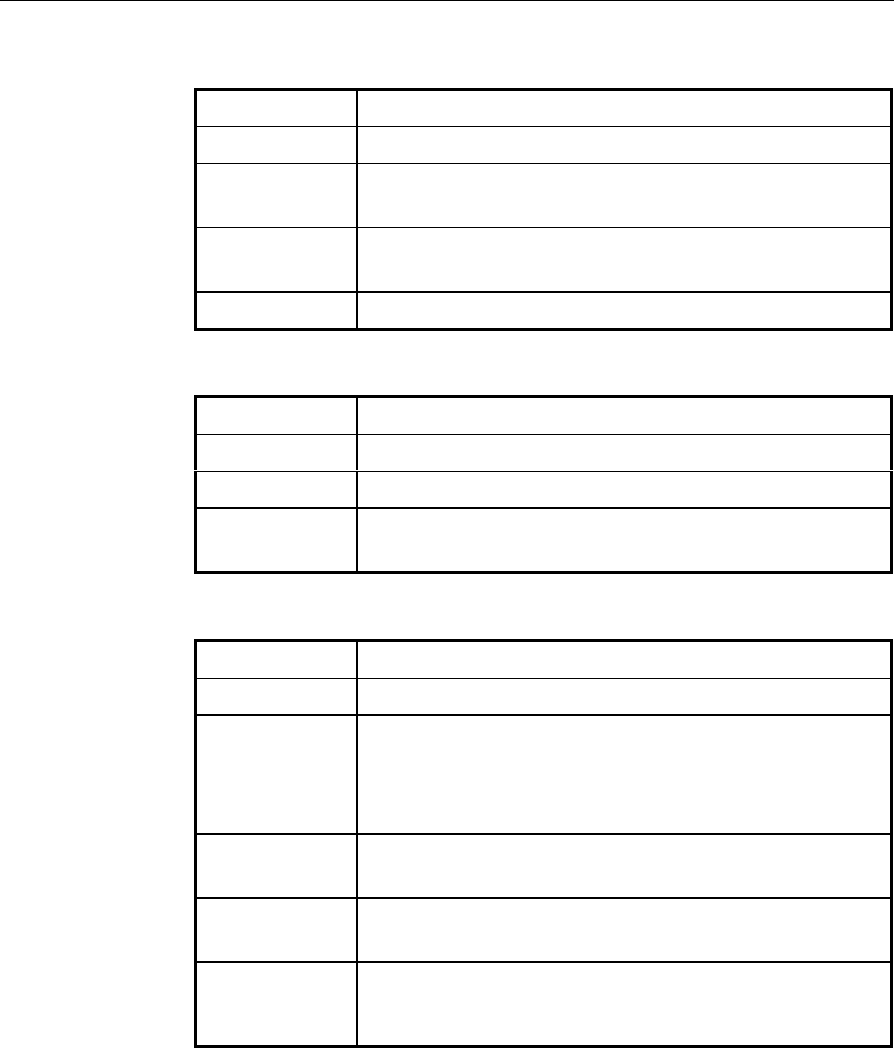
Configuring the DecisioNet System Environment 8-3
Menu Bar Navigation
F10 Toggle key that activates and deactivates menu
←
←←
← →
→→
→Moves from choices in the active menu
Hot Key The underlined or highlighted character in the active
menu choice that will execute that menu choice
Enter or Space From active menu choice, displays either pulldown
or dialog box
↓
↓↓
↓Displays pulldown
Pulldown Navigation
←
←←
← →
→→
→Leaves pulldown and returns to menu bar
↑
↑↑
↑ ↓
↓↓
↓Moves through pulldown
Space or Enter Executes pulldown choice
Hot Key Executes - From active menu choice, displays either
pulldown or dialog box
Keystrokes for Navigating in the Dialog Box
Tab Moves the current position forward, field by field.
Shift + Tab Moves the current position backward, field by field
Space(bar) (1) From a radio list, selects the current button
(2) From a check box, selects or deselects the box
(3) From a list box, selects the current item in the
list item
←
←←
← →
→→
→In a list or field, moves the current position forward
or backward within the field or list field.
↑
↑↑
↑ ↓
↓↓
↓In a list box, moves up or down the list. Use the
spacebar to select an item in the list.
Enter (1) From a field, executes the default (highlighted)
button
(2) From a button, executes the current, selected

8-4 Configuring the DecisioNet System Environment
button

Configuring the DecisioNet System Environment 8-5
Setting Performance Boost in Windows NT 4.0
Following installation, set the foreground and background
applications to get equal time.
1. Select the Control Panel from the Settings menu from the Start icon.
2. Choose the System icon.
3. Click on the Performance tab.
4. Slide the Boost Selector to “None” to indicate “No Performance
Boost.”
5. Click on Apply to accept these changes.
6. Click on OK in the Performance Dialog Box.
7. Close the Control Panel.
Configure the system as described in this chapter, beginning with the
section “Configuring the CBS Communications.”

8-6 Configuring the DecisioNet System Environment
Configuring the CBS Communications Port
Before you can run the DecisioNet software, you must configure the
CBSCOMM Port variable in the basesw.cfg file. This ASCII file is in the
following directories in a default system:
Windows NT \epl\data
NCR UNIX /appl/epl/data
SCO UNIX /appl/epl/data
To change these parameters you must edit them from the DOS or
UNIX prompt with an editor.
Locate the following section in the file and set the variable to the serial
port or serial device where the EPL converter is connected in your
system. The serial port used by the DecisioNet software must not be
used by other applications within the system.
#Specifies RS-232 device name
# Mandatory.
"CBSCOMM_PORT", <port/device name>
For example:
Windows NT "COM1" or "COM2"
NCR UNIX "/dev/term/s001"
SCO UNIX "/DEV/TTY1a"
Caution: Other variables in the base software configuration file are set
to system defaults and may be modified using the EPL Administration
application. Editing them directly with a ASCII editor may cause
system problems. Refer to Appendix C for a sample listing of all the
basesw.cfg file variables.

Configuring the DecisioNet System Environment 8-7
Starting the DecisioNet System
You must start the DecisioNet System before performing the EPL tag
functions.
To Start the DecisioNet System in Windows NT
From the EPL Applications Programs group, select Start EPL
Applications. To stop the application software, select Stop EPL
Applications.
Note: If the DecisioNet software has been configured to start as an
automatic service on your system, there is no need to start the
application manually.
To Start the DecisioNet System in NCR UNIX or SCO UNIX
At the UNIX command line, type startepl. The command to shut
down the DecisioNet System is stopepl.

8-8 Configuring the DecisioNet System Environment
Configuring the DecisioNet System Software
After installing new software, you must configure the following
DecisioNet System parameters for your store's environment:
• Application Configuration
• Base Hardware
• Label Data Maintenance (LDM)
Note: Basic LDM functionality is provided in the EPL Base
Application Runtime software. To access all the options described
within this configuration chapter, you must purchase and install the
EPL Information Messaging System package for enhanced LDM
functionality.
To access these parameters you must start EPL Administration.
1. Access and start EPL Administration as follows:
Windows NT Select EPL Administration from the EPL
Applications Programs group.
NCR UNIX and
SCO UNIX Type esadmin at the UNIX prompt and
press Enter.
2. In the Username and Password fields, enter hardware and config1.
(These are the default entries that access EPL Administration and
permit modification to the Base Hardware Configuration screen
parameters. Other default entries, system and manager, only
permit viewing of the base hardware parameters but permit access
to all other EPL Administration functions.) Refer to the “About
Passwords” section later in this chapter for details about password
security.
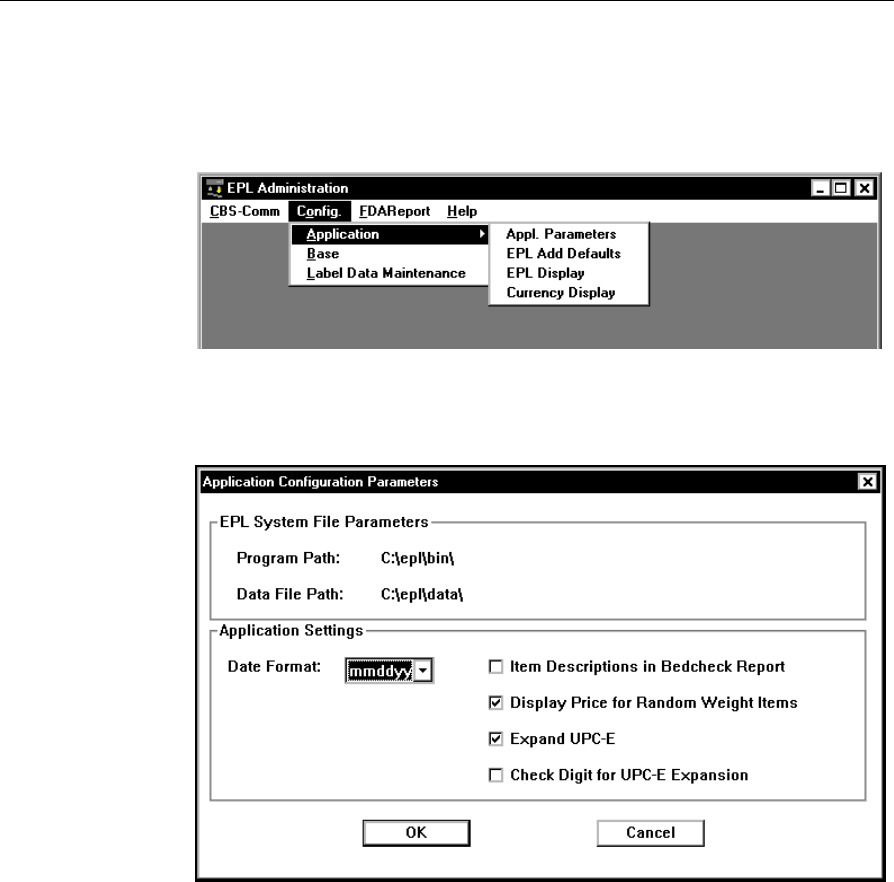
Configuring the DecisioNet System Environment 8-9
3. Select Config from the EPL Administration main menu bar.
The EPL Administration screen displays when you select Config
from the EPL Administration Main menu bar.
4. Highlight Application and select Appl. Parameters from the
pulldown list to display the Application Configuration Parameters
screen.
5. Enter the date format and select one or more application settings
from this screen. Select OK to return to the EPL Administration
main menu bar.

8-10 Configuring the DecisioNet System Environment
Field Descriptions
Below are field descriptions of the Application Configuration
Parameters dialog.
Date Format
Set the date format to mmddyy, ddmmyy, or yymmdd. The specified
format is used on all display screens, reports, and logs.
Item Descriptions in Bedcheck Report
This parameter lists the descriptions for each item (e.g., coffee) when
you run a bedcheck report.
Display Price for Random Weight Items
This parameter enables you to display the unit price for random weight
items in the price field. For example, the system can handle random
weight items by the pound, such as hamburger meat.
Expand UPC-E
Each item is usually associated with the a Universal Product Code
number. This option determines whether the UPC-Es are expanded.
UPC numbers are typically 12 digits, but a UPC-E is seven or eight
digits. The series type “E” in a UPC is the compressed form of the
standard UPC-A.
Check Digit for UPC-E Expansion
Every UPC number is divided into four parts: NSC character,
manufacturer number, item number, and check digit. The check digit
verifies the validity of the UPC number. When an item is scanned, the
scanner can be configured to whether to strip the Check Digit. This
information is necessary so that you can accurately expand an item
with the UPC-E to its original form.
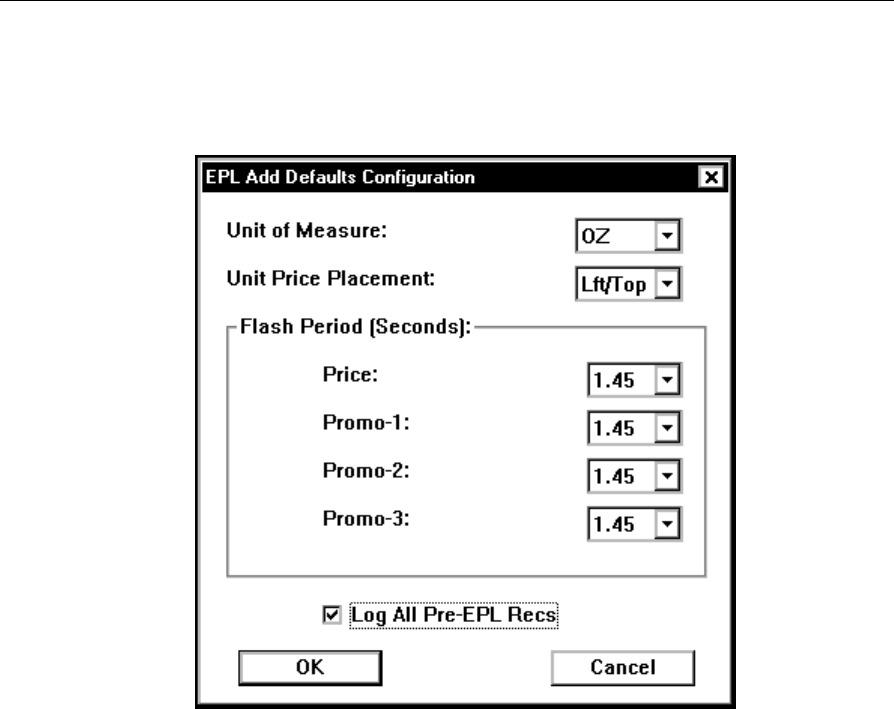
Configuring the DecisioNet System Environment 8-11
6. Highlight Application and select EPL Add Defaults from the
pulldown list to display the EPL Add Defaults Configuration
screen.
7. Enter the parameters for your system on this screen. Select OK to
return to the EPL Administration main menu bar.
Field Descriptions
The following are field descriptions of the EPL Add Defaults dialog.

8-12 Configuring the DecisioNet System Environment
Unit of Measure
The following table shows the units of measure available in the
esmeasur.tbl configuration file. Additional values may be added by
editing the file. The value selected here is the default value that
displays in the Unit of Measure field of all EPL Maintenance dialog
boxes. Refer to Appendix C for additional information about the
esmeasur.tbl.
OZ mL CT Pint
LB Gal. Kg 100 Units
g QT Pound 50 Sq. Ft.
L PT Quart 100 Sq. Ft.
Unt Prc Plcmnt
This parameter identifies where the Unit Price displays on the
SmarTalker tags used in your environment. The value selected
determines the default value that displays in the EPL Type field of Add
EPL Maintenance dialog boxes.
Parameter Add EPL Maintenance dialog EPL Type field default
Lft/Top Standard, Left Unit Price (1 Std. LUP)
Small, Left Upper Unit Price (3 Sml. UUP)
Standard, Left Unit Price (5 V2 Std.LUP)
Small, Upper Euro Price (8 V2 Euro Sml.)
Standard, Upper Left Euro Price (7 V2 Euro Std)
Rt/Btm Standard, Right Unit Price (2 Std. RUP)
Small, Right Lower Unit Price (4 Sml. RUP)
Standard, Right Unit Price (6 V2 Std.RUP)
Small, Lower Unit Price (9 V2 Small)

Configuring the DecisioNet System Environment 8-13
Flash Periods (seconds)
This is the default length of flash periods for adding an EPL. It
indicates the number of seconds the entries for Price, Promo-1, Promo-
2, and Promo-3 display before changing to the next display field.
Available options are:
.72
1.45
2.90
5.80
Log All Pre-EPL Recs
If this option is checked, when you add a pre-EPL file to the system, an
entry for each EPL record successfully added, is written to the EPL
Audit Log. The Audit Log could then be printed and saved for
reference, and then cleared to free up the disk space. Pre-EPL records
that fail are recorded in the EPL System Error log. Using this option for
an initial pre-EPL file load requires additional disk space for the Audit
Log records. This option may be more useful when adding pre-EPL
files following the initial load to maintain a record of what was added.
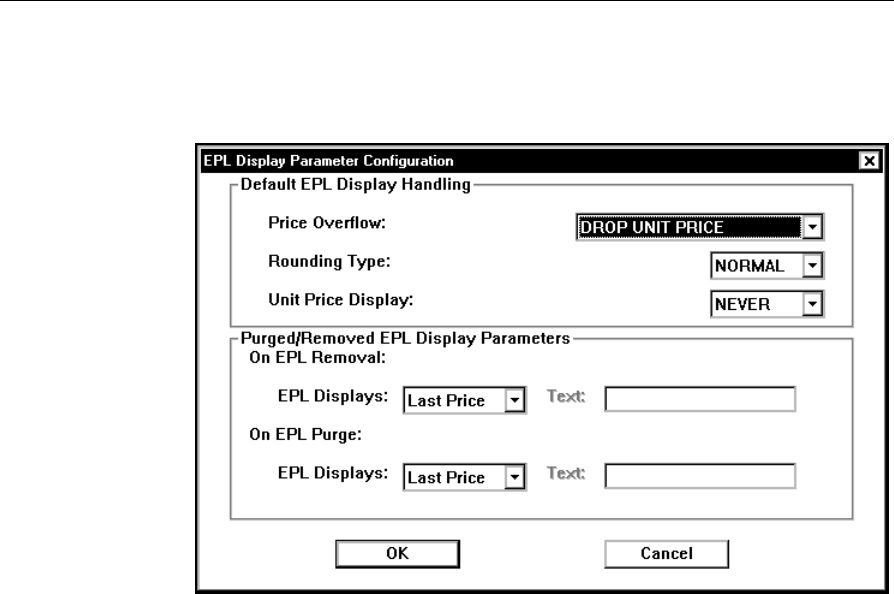
8-14 Configuring the DecisioNet System Environment
8. Highlight Application and select EPL Display from the pulldown
list to display the EPL Add Display Parameter Configuration
screen.
9. Enter the parameters for your system on this screen. The
parameters shown are the DecisioNet System defaults. Select OK to
return to the EPL Administration main menu bar.
Field Descriptions
Default EPL Display Handling section
Price Overflow
If the retail price is greater than the maximum number of allowable
digits, you can either choose DROP UNIT PRICE, which ceases to
display the unit price, or you can choose DROP SIGNIFICANT
DIGITS, which drops the least significant digit. If you are dropping
the least significant digit and the price is 1,350.45, only 1,350 would
display on the EPL. For example, the maximum number of allowable
digits for SmarTalker I and II standard tags is four digits, SmarTalker II
2x6s allow six digits and 2x5s allow five digits.

Configuring the DecisioNet System Environment 8-15
Rounding Type
NORMAL
If the digit to the right of the least significant digit is a 5 or greater,
round up. Otherwise, round down. Example: 38.78 cents becomes
38.8 cents, 38.71 cents becomes 38.7 cents.
ROUND-UP
If a digit to the right of the least significant digit is not zero, round
up. Example: 38.78 cents becomes 38.8 cents. 38.71 becomes 38.8
cents.
TRUNCATE
Ignore digits to the right of the least significant digit. Example:
37.78 cents becomes 38.7 cents. 38.71 cents becomes 38.7 cents.
Unit Price Display
When adding an EPL tag to the system, this parameter gives you the
option to: ALWAYS or NEVER display the unit price, or ASK the user
during EPL Maintenance Add or Change EPL functions whether or not
the unit price should be displayed on a particular EPL tag. If ASK is
selected as the default here, the EPL Maintenance screen displays an
additional check box next to the Mark for Printing check box. The
additional check box is then used to indicate if the unit price for the
new EPL is to be displayed.
Purged/Removed EPL Display Parameters section
On EPL Removal / On EPL-Purge
This option allows you to display a configurable message when an
item is deleted and/or purged from the system. The options are:
• Last Price: Indicates no change to the tag. The price on the tag when
the tag is deleted and/or purged will remain on the tag.
• Enunciators: Indicates that all text will be cleared from the tag and
that all “.s” and “,s” (dots and commas) will be turned on.

8-16 Configuring the DecisioNet System Environment
• Text: Allows you to enter text that will be displayed on the tag
when the tag is deleted and/or purged.
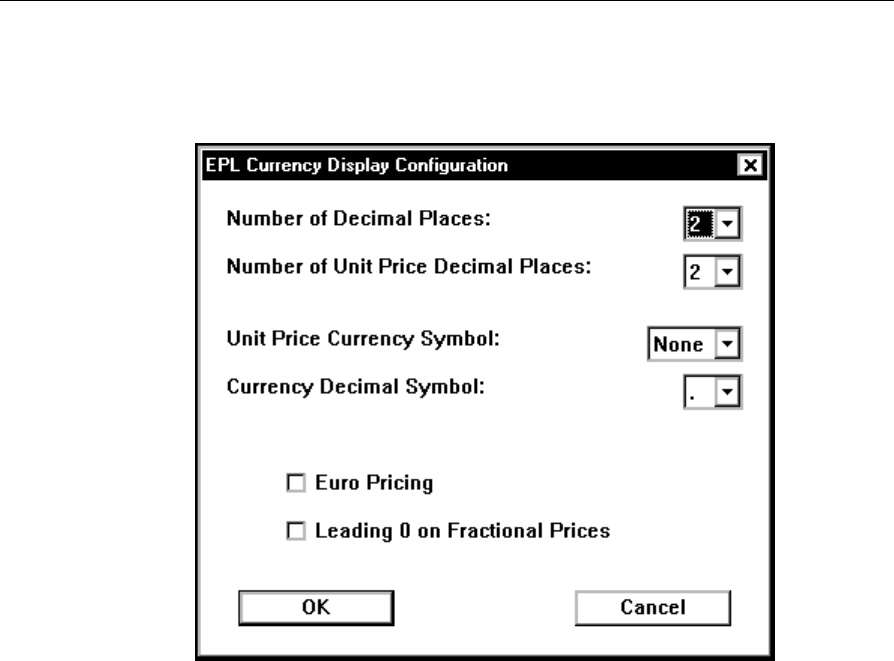
Configuring the DecisioNet System Environment 8-17
10. Highlight Application and select Currency Display from the
pulldown list to display the EPL Currency Display Configuration
screen.
11. Enter the parameters for your system on this screen. The
parameters shown are the DecisioNet System defaults. Select OK to
return to the EPL Administration main menu bar.
Note: Unit Price Currency Symbol and Euro Pricing are mutually
exclusive.

8-18 Configuring the DecisioNet System Environment
Field Descriptions
Number of Decimal Places
This parameter (0, 2 or 3), identifies the decimal position used when
displaying price data on the SmarTalker tags.
0: 00 (No decimal point)
2: 0.00 (2 digits to the right of the decimal point)
3: 0.000 (3 digits to the right of the decimal point)
Unit Price Currency Symbol
This field gives you three options: Cent, Euro, and None. If the cent
option is selected, the cent sign (¢) is displayed with the unit price on
the SmarTalker. For example, a unit price of 12.79 would display as
12.7¢. With the option off, it would display as 12.79. If Euro Pricing is
selected, do not select Cent as the Unit Price Currency Symbol.
Currency Decimal Symbol
Two options are available. A decimal point (.) and a comma (,). When a
comma is selected as the currency symbol, it displays on the screen and
in DecisioNet System reports, but does not display on the SmarTalker.
This option turns on the Euro symbol on the 7 V2 Euro Std. and 8 V2
Euro Sml. EPL tag types. The symbol will display on a tag the first time
a price change is made after this option has been set. This option is
intended for use with Euro pricing only.
Euro Pricing
This option turns on the Euro symbol on the 7 V2 Euro Std. and 8 V2
Euro Sml. EPL tag types. The symbol will display on a tag the first time
a price change is made after this option has been set. This option is
intended for use with Euro pricing only.
Leading 0 on Fractional Prices
This option places a zero before the decimal. For example, choosing
this option will change “.25” to “0.25.”
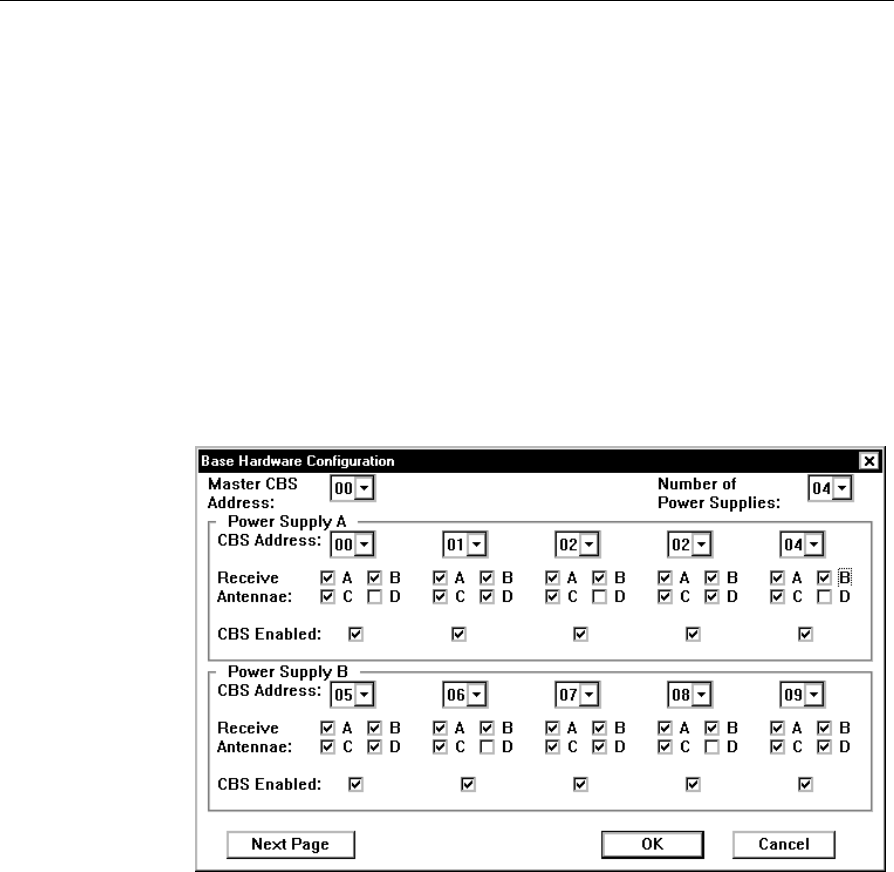
Configuring the DecisioNet System Environment 8-19
Base Hardware Configuration
The CBS, power supply, and receive antenna configuration is identified
the Base Hardware Configuration screen. This information must match
the physical layout of the store. It is used by the Failure Detection and
Analysis software to monitor the store’s EPL hardware and cable
integrity. The cable illustration in the section “System Cable
Connection” of Chapter 4 may be helpful when making the entries
required in the following sections.
To access the Base Hardware Configuration screen, use the left and
right arrow keys to select Config. from the EPL Administration main
menu, highlight Base, and press Enter.
The Base Hardware Configuration screen displays.
The following are explanations of the parameters on the Base
Hardware Configuration screen.

8-20 Configuring the DecisioNet System Environment
Master CBS Address
Identify the address of the Master CBS. This is the CBS connected to the
RS-232/RS422 Converter. On the previous screen, 00 is the Master CBS.
1. Use the Tab key to move the Master CBS Address selection box.
2. Use the down and up arrow keys to highlight the desired address.
3. Press the Tab key.
Number of Power Supplies
Identify the number of power supplies installed in your system. One
power supply is required for each five (5) CBSs. There are 4 power
supplies in the example configuration
1. Use the down and up arrow keys to highlight the desired number.
2. Press the Tab key.
Note: Additional screens are provided for configuring CBS Address
and Receive Antenna locations when more than two (2) power supplies
are defined. Navigational buttons (Next and Previous) are provided to
access the additional screens. In the example layout, there would be
two screens with Power Supplies A, B, C, D corresponding to the
Power Supply 1, 2, 3, and 4 in the illustration.
CBS Address
Identify the CBS Address for each CBS installed in the store, including
the Master CBS. CBS Addresses range from 0-19. Addresses for the
CBSs associated with Power Supply A (Power Supply 1 in the example)
would be 00, 01, 02, 03, and 04.
1. Use the Tab key to move the CBS Address selection box.
2. Use the down and up arrow keys to highlight the desired address.
3. Press the Tab key.
Note: CBSs associated with Power Supply B would be 05, 06, 07, 08
and 09.

Configuring the DecisioNet System Environment 8-21
CBS Enabled
This options lets you disable a CBS in the situation where you might
not want it communicating within the store. The default option is
disabled. You must enable all the CBSs initially.
1. Use the Tab key to move to each CBS Enabled check box. The
cursor position or focus is actually an area to the right of the check
box.
2. Press the Space bar to check the box
Receive Antenna
For each CBS, identify the ports (A, B, C, and D) where receive
antenna are connected.
1. Use the Tab key to move to corresponding check box.
2. Press the Space bar to check the box
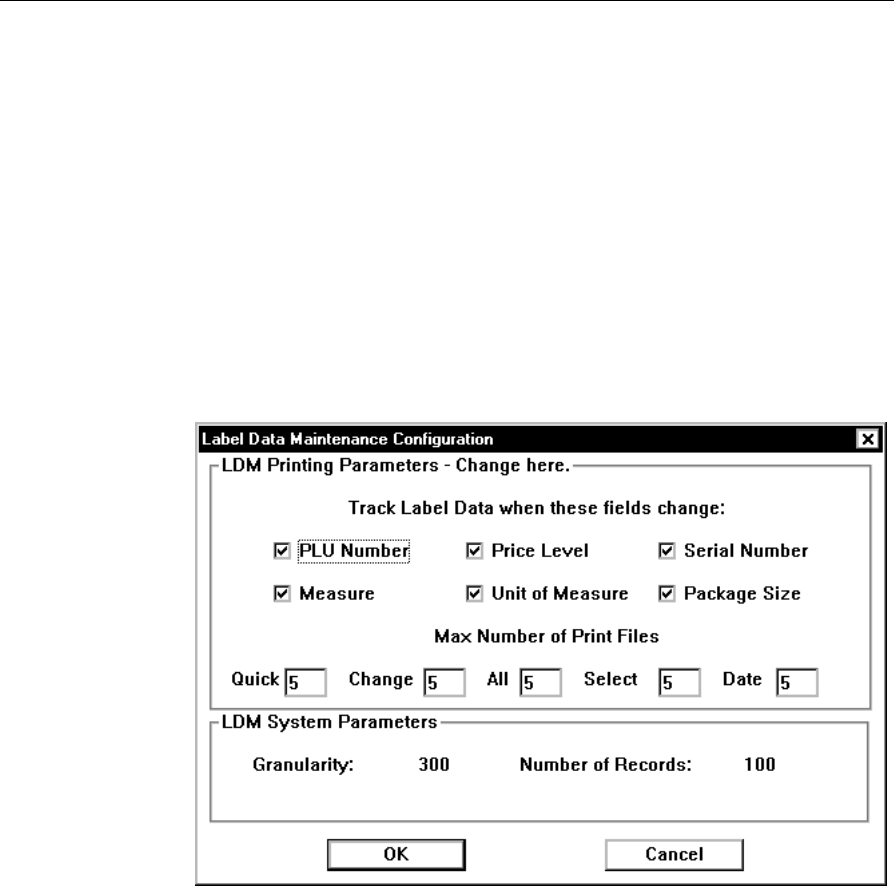
8-22 Configuring the DecisioNet System Environment
Label Data Maintenance (LDM)
LDM tracks changes affecting SmarTalker overlays. It converts change
data from data files into ASCII text files that can be printed and used
for creating new overlays. Basic LDM functionality is provided in the
EPL Base Application Runtime software. To access all the options
described within this configuration chapter, you must purchase and
install the EPL Information Messaging System package.
To access the Label Data Maintenance Configuration screen, use the
left and right arrow keys to select Config. from the EPL Administration
main menu, use the up or down arrow key to highlight Label Data
Maintenance, and press Enter. The following screen displays.
The following are explanations of the parameters on the Label Data
Maintenance Configuration screen.

Configuring the DecisioNet System Environment 8-23
Track Label Data when these fields change section
Identify the label data fields to track by checking the associated option
box. When changes are made to EPL table records through EPL
maintenance functions, a flag corresponding to the selected fields is set
to mark the record for printing. Depending on the type of print option
selected, flags are reset following the label print operation.
PLU Number
Track label data when the PLU number of an EPL item changes.
Price Level
Track label data when the price level of an item changes. The price
level is an item specification that is defined by the user. An example of
its use could be if different sizes of an item are on the same PLU
number, and the price level could be used to differentiate the sizes.
Serial Number
Track label data when the SmarTalker serial number assigned to an
EPL record changes.
Measure
Track label data when the measure changes. Measure is a conversion
factor necessary to calculate the correct unit price (price per)
information by converting the product’s unit of measure to the
displayed unit price unit of measure. The displayed unit price unit of
measure is the price per unit of measure.
For example, if the store wants the unit price of a 12 ounce can of cola
to be per ounce, the measure is 1 because the product unit of measure
and the unit price unit of measure are the same. If the unit price unit of
measure is to be displayed as price per quart in this example, the
measure is 32, the number of ounces in a quart.
Unit of Measure
Track label data when the unit of measure changes. The unit of
measure is how this product is packaged. A 12 ounce can of cola has a
unit of measure of ounce or oz. Other units of measure include pound,
kilogram, and liter which are abbreviated as lb, kg, and L.

8-24 Configuring the DecisioNet System Environment
Package Size
Track label data when the package size changes. The package size is
the number of units of measure in the package. For example, if the Unit
of Measure is “oz,” the package size might be 3.2 to denote 3.2 ounces
per package.
Maximum Number of Print Files section
Each time you run each of the types of reports discussed below, a file is
generated. The number in the field next to each type of report
determines how many versions of the report are kept. For example, if
the number 5 is in the Quick field, the last 5 versions of the Quick
report are kept in the directory, epl\data\ldffiles for Window NT and
/appl/epl/data/ldffiles for NCR UNIX and SCO UNIX. The minimum
number is one (1) which would keep only the current file.
Quick
The maximum number of quick print files that can be stored in the
LDM files directory. Quick print files are in data format and have not
yet been converted to ASCII. Quick print files contain information on
description changes gathered in the previous scan of the PLU file and
current EPL Table changes. All flags are reset with this print option.
Change
The maximum number of ASCII print files containing change
information that can be stored in the LDM files directory. These files do
not contain information on every EPL record, only the records that
have been changed. This includes current PLU file description changes
if extended LDM functionality is installed and current EPL Table
changes. All flags are reset with this print option.
All
The maximum number of ASCII print files containing all EPL records
that can be stored in the LDM files directory. An All print file contains
information on all EPL labels regardless of whether the specified fields
have changed or not and the latest descriptions from the PLU file if
extended LDM functionality is installed. Flags are not reset with this
print option.

Configuring the DecisioNet System Environment 8-25
Select
The maximum number of Select ASCII print files that can be stored in
the LDM files directory. Select print files contain label information for
EPL Table records specified by the user for a range of serial numbers or
PLU item numbers. Flags are not reset with this print option.
Date
The maximum number of Date ASCII print files that can be stored in
the LDM files directory. Date print files contain label information for
EPL Table records added within the given date range. Flags are not
reset with this print option.
LDM System Parameters section
The following settings can be viewed on the Label Data Maintenance
Configuration screen, but can only be changed in the basesw.cfg file.
Refer to Appendix C and Appendix D for information about
Configuration Files and Customizing the DecisioNet System. These are
extended LDM functions available only when the EPL Information
Messaging System package is installed.
Granularity
The time interval (in seconds) between the times that LDM checks the
PLU file for description field changes. The default is 300 seconds.
Number of Records
The maximum number of records LDM reads at one time when
checking for description field changes. The larger this number the
faster LDM performs the checks. However, LDM reads this number of
records into memory, so more memory is required for larger values.
The default is 100.

8-26 Configuring the DecisioNet System Environment
Configuring Windows NT Services
You can start or stop the EPL system software:
• as console applications from
• the DOS prompt, or
• the programs in the EPL Applications Programs group;
• or as manual or automatic services on Windows NT. Automatic
service is the method recommended for the reasons specified
below.
Services can start automatically or manually. The advantages of
running the applications as automatic services are:
• Ease of Use - When an application runs as an automatic service, no
one has to log in and start it. It starts and runs by itself in the
background when the system boots.
• Security - Someone who wants to log on and start or run software
that was not started as a service must know and use the Windows
NT account ID and Password, and the application account ID and
Password.
The following software can be run as services for the indicated
DecisioNet applications:
EPL Package Applications Available as Services
EPL Base Runtime
Package EPL Bedcheck
EPL CBS Manager
EPL Logger
EPL Data Scheduler
EPL Table Manager
EPL Bridge
EPL Standalone PLU
Maintenance EPL Standalone PLU Reader
EPL System
Information Package EPL Failure Detection and Analysis
EPL Log Monitor
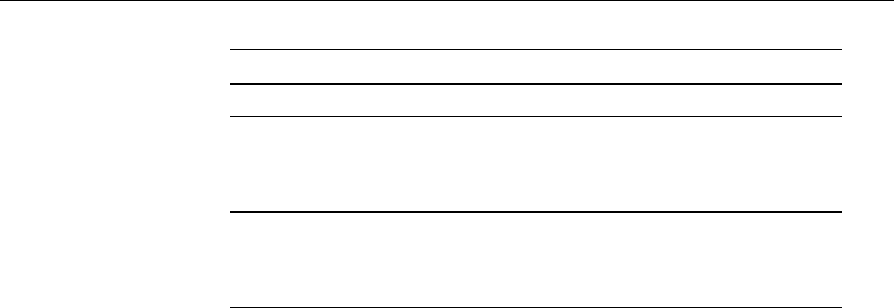
Configuring the DecisioNet System Environment 8-27
EPL Package Applications Available as Services
EPL Status Tag Manager
EPL Price
Redundancy Package EPL Sale Price Verifier
EPL Price Verifier
EPL Price Checker
EPL Information
Messaging System
Package
EPL Label Data Manager
EPL External Data Interface
EPL Promotional Message Verifier
Automatic Start When Running DecisioNet as a Service
If you want the DecisioNet software, or parts of it, to start
automatically as services, configure the Windows NT Service as
described here.
Note: There must be an entry in the base software configuration file
for each service you want to start automatically. Refer to the “Windows
NT Automatic Services” section in Appendix D for details.
1. From the Control Panel, double click on the Services icon.
2. For the EPL service you want to automatically start:
a. Highlight the service.
b. Click on the startup button.
c. Select the Automatic radio button in the Startup Type box.
d. Select System Account or This Account in the “Log On As” box. If
This Account is selected, enter the valid user account
information previously created using the Windows NT User
Manager.
e. Click on OK in the Service dialog box.
4. Repeat Step 2 for each service you want to start automatically.
5. When done, click on Close in the Services dialog box.
6. Reboot the system to start the configured services.

8-28 Configuring the DecisioNet System Environment
Manual Start When Running DecisioNet as a Service
You can start the DecisioNet software, or parts of it, manually as a
service at a DOS prompt.
Note: The default setting is manual for the services listed in the table
at the beginning of this section. Any services that have been changed
from manual will not start using the following procedure.
1. To start services manually, type runepl startservices from the
\epl\bin directory at the DOS prompt. A script file starts the
services that you have configured to run manually.
2. To stop services, type stopepl from the \epl\bin directory. A
script file stops the services that are configured to run manually.
Manually Starting DecisioNet as an Application
You can start DecisioNet applications using the following two
methods.
• From a DOS prompt:
• Type startepl from the \epl\bin directory.
• From the Programs Group:
• Select Start EPL Applications from the EPL Applications
Programs group.
For information on using the DecisioNet EPL applications, see the NCR
DecisioNet System User’s Guide (B005-0000-1087).

Configuring the DecisioNet System Environment 8-29
About Passwords
You must enter the Username and Password to operate any of the three
major function areas. You can assign the Username and Password in
EPL Administration with any of three security levels.
Assigning Security
The DecisioNet System provides three security levels for the users. The
default Username is system and the default password is manager, and
this Username has Level 3 security access.
The following table summarizes the security levels in the DecisioNet
System:
Security Level EPL
Administration EPL
Maintenance Password
Maintenance Display
Register Standalone EPL
Item Maintenance
Level 3 (Highest
and Default) √ √√√√
Level 2 √√ √
Level 1 (Lowest) √√
To protect the DecisioNet System from unauthorized access, you must
change the password on the system Username to a password other
than manager once you have installed the system. Adding additional
users with less security access also helps to protect the DecisioNet
System.
Maintaining Username/ Password
You can add, change, or delete a Username and Password by going to
the EPL Administration window and clicking on the Password menu.
The Username/Password Maintenance screen displays.
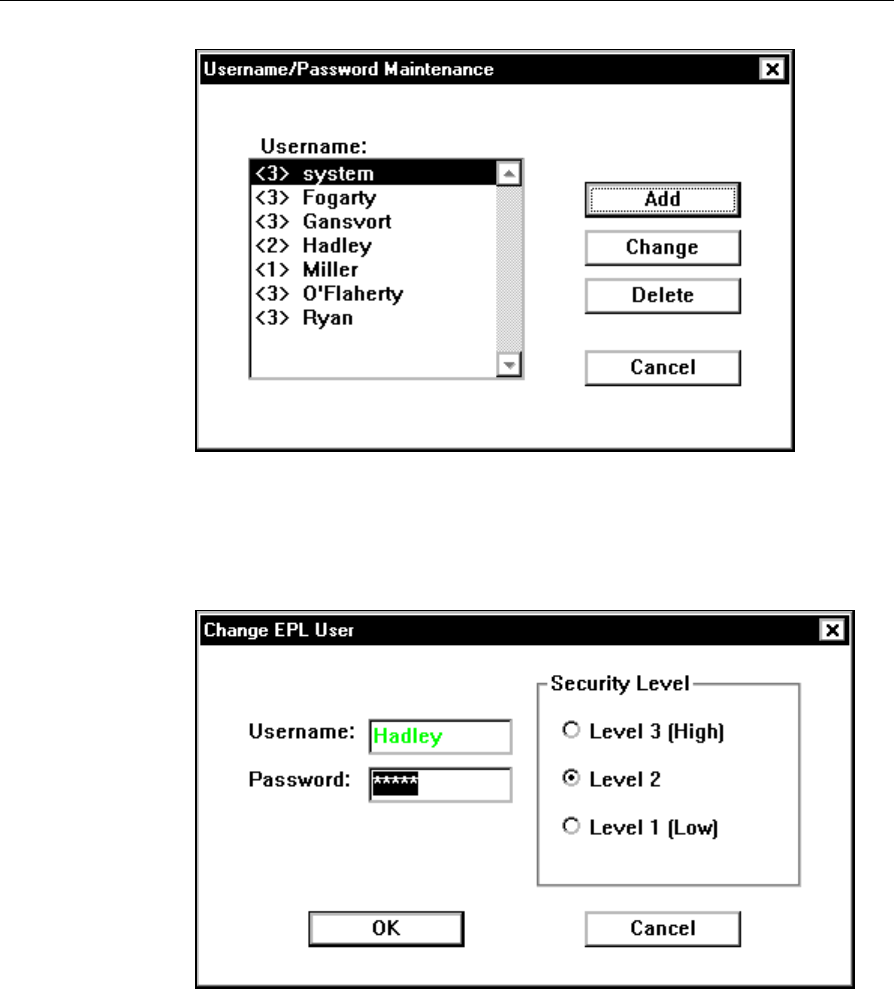
8-30 Configuring the DecisioNet System Environment
By selecting Add, you can assign a new Username and Password. The
Security Level of the user may also be assigned.
By selecting Change, you can change the Password or Security Level of
the selected user, but not the Username.
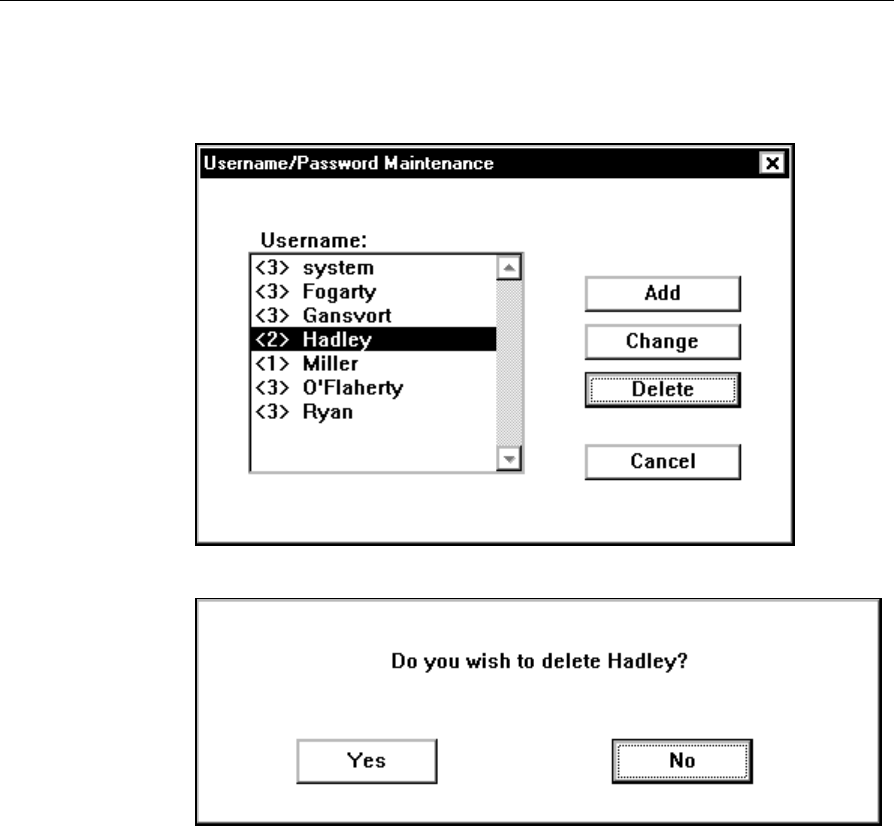
Configuring the DecisioNet System Environment 8-31
On the Username/Password Maintenance screen, you can delete a
username/password by highlighting a username, selecting delete, and
confirming the deletion.

8-32 Configuring the DecisioNet System Environment